1998-1999 Olympiad Correspondence Problems
Set 3
- 13.
-
The following construction and proof was proposed
for trisecting a given angle with ruler and Criticizecompasses
the arguments.
-
-
Construction.
Let the angle to be trisected be BAC. With
center A and respective radii of two, three and four units, draw
arcs PU, QV and RW to intersect the arms of the angle.
Determine D, E, F and G, the respective midpoints of arcs
PU, RW, RE and EW. Let M and N be the respective intersections
of the segments FD and GD with the arc QV. Then the rays MA
and NA yield the desired trisection of angle BAC.
-
-
First proof. Let H be the midpoint of
arc QV. Consider the ``triangles'' DMH and DFE, one
side of each being a circular arc. Since the arcs RW and QV are
parallel, ÐDFE = ÐDMH and ÐDEF = ÐDHM, so that
triangle DMH is similar to triangle DFE. Since 2DH = DE, it
follows that arc MN = 2 arc MH = arc FE. Now, arc QV =
(3/4) arc RW = 3 arc FE and arc QM = arc NV. Therefore, the
arc QV is trisected by M and N, and so the construction is
valid. QED
-
-
Second proof. Since arc RW = 2 arcPU, arc PD = arc RF.
Therefore, FD is parallel to RP, and so arc QM = arc RF.
Similarly, arc NV = arc GW = arc RF. Since arc QV = 3 arc
RF, QV is trisected by M and N. QED
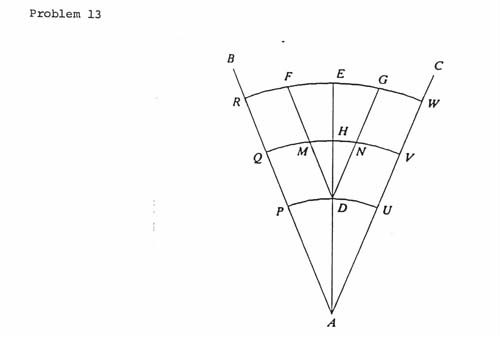
View solution
- 14.
-
The following construction was proposed for ``squaring
the circle'' with ruler and compasses, i.e., constructing
a square of equal area to a given circle. Criticize the
proposed construction. You can take it for granted that it is
possible to construct a square equal in area to a given
quadrilateral.
-
-
Suppose we are given a circle of diameter d. The problem is to show
that, using ruler and compasses, we can construct a square of area
equal to that of a circle. As in the figure, construct an
isosceles right triangle ABC whose equal sides have length d.
Let the hypotenuse BC
be the diameter of a semi-circle passing through A, and let semi-circles
also be constructed on diameters AB and AC. The area of the larger
semi-circle is equal to twice that of each of the smaller, and it is
not hard to argue that the sum of the areas of the two lunes (marked
L) is equal to the area of the triangle (marked R).
-
-
Now construct a trapezoid DEFG which is the upper part of a regular
hexagon of side d. Thus DG = 2DE = 2EF = 2FG = 2d. The area of
the semi-circle with diameter DG is four times the area S of the
semi-circle of diameter d constructed on each of the sides DE,
EF, FG as diameter. It can be seen that the area S plus the area
of the three lunes (L) is equal to the area of the trapezoid (T).
-
-
Symbolically, we have R = 2L and T = 3L + S. Hence the area of
the given circle is 2S = 2T - 6L = 2T - 3R. Thus, we have been
able to construct rectilinear figures some linear combination of which
will yield the area of the circle. It is known that one can construct
with ruler and compasses a square whose side is equal to 2T - 3R.
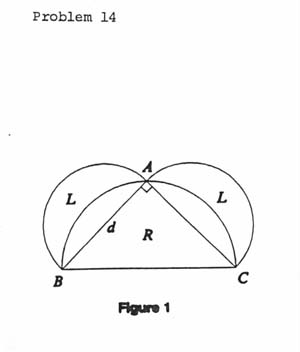
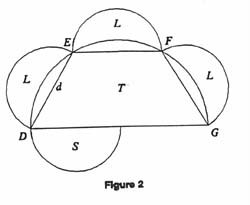
View solution
- 15.
-
A faulty proof is given for the following result.
Find the flaw in the proof and give a correct argument.
-
-
Proposition. If in a triangle two angle bisectors
are equal, then the triangle is isosceles.
-
-
Proof. Let BAC be the triangle and AN, CM the two
equal bisectors, with N and M on BC and AB respectively. Suppose
the perpendicular bisectors of AN and CM meet at O. The circle
with center O passes through A, M, N, C. Angles MAN
and MCN, subtended by MN are equal. Hence, the angles
BAC and BCA are equal, and the result follows. QED
View solution
- 16.
-
Criticize the solution given to the following problem
and find a correct solution.
-
-
Problem. ABC is an isosceles triangle with
AB = AC. The point D is selected on the side AB so that
ÐDCB = 15° and BC = Ö6 AD. Determine the
degree measure of ÐBAC.
-
-
Solution. Let AB = AC = 1 and
let ÐDCA = a, where 0 < a < 75°.
Then BC = 2cos(15° + a). The Sine Law applied
to triangle ADC yields
|
|
1
sin(30° + a)
|
= |
CD
sin(150° - 2a)
|
|
|
whence
|
CD = |
sin(150° - 2a)
sin(30° +a)
|
. |
|
Applying the Sine Law to triangle DBC yields
|
|
2cos(15° + a)
sin(30° + a)
|
= |
BC
sin(150° - a)
|
= |
CD
sin(15° + a)
|
= |
sin(150° - 2a)
sin(15° + a) sin(30° + a)
|
. |
|
Hence
|
sin(30° + 2a) = 2cos(15° + a)sin(15° + a) = sin(150° - 2a) |
|
so that 30
° + 2
a = 150
° - 2
a
with the result that
a = 30
°. Hence
ÐBAC = 150
° - 2
a = 90
°.
QED
-
-
This checks out: BC = Ö2 and AD = 1/Ö3.
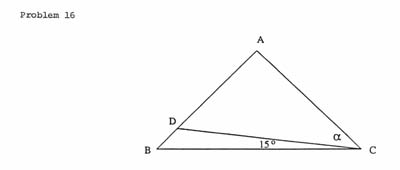
View solution
- 17.
-
Criticize the solution given to the following problem
and determine a correct solution.
-
-
Problem. Let A¢, B¢ and C¢ denote the feet of
the altitudes in the triangle ABC lying on the
respective sides BC, CA and
AB, respectively. Show that AC¢ = BA¢ = CB¢ implies that
ABC is an equilateral triangle.
-
-
Solution. Let k = AC¢ = BA¢ = CB¢ and let u = CA¢, v = AB¢, w = BC¢. By the Law of Cosines,
|
(k+u)2 = (k+v)2 + (k+w)2 - 2(k+v)(k+w)cosA |
|
whence
|
(1 - 2cosA)k2 + 2((v+w)(1 - cosA) - u)k + (v2 + w2 - u2 - 2vwcosA) = 0 . |
|
Equating coefficients to zero yields in particular that
1 - 2cosA = 0 or
q = 60
°.
QED
View solution
- 18.
-
Analyze the solution of the following problem.
In the days before calculus, one way to check the tangency of two
curves with algebraic equations f(x, y) = 0 and g(x, y) = 0 at
a common point (a, b) was to eliminate one of the variables
from the system of two equations and to check whether the resulting
equation in the other variable had a double root corresponding to the
common point. As a simple example, y = x2 and y = 2x - 1
represent curves tangent at (1, 1) because x2 = 2x - 1 has a
double root at x = 1.
-
-
Problem. Find all values of k for which the curves
with equations
|
y = x2 + 3 and |
x2
4
|
+ |
y2
k
|
= 1 |
|
are tangent.
-
-
Solution. Eliminating x yields the equation
for the ordinates of the intersection points
of the two curves. If the curves are to be tangent, the quadratic
equation should have a double root, so that its discriminant
k
2 + 112k vanishes. Since k = 0 is not admissible, k
must be -112.
QED
-
-
With the aid of a sketch, it is not hard to see that k = 9 also
works. Why is it not turned up by this argument?
View solution
Problem 13.
- 13.
-
First solution. In the first solution, the
assertion that the two ``triangles'' with common vertex are
similar is confounded by the fact that the curved lines are
not arcs of circles with their centres at the common vertex,
so that there is no similarity transformation which takes one
to the other. For suppose otherwise. They would have to be
related by a similarity transformation with centre D
which carries E to H. The factor of this similarity would
have to be 1/2. The arc FE would have to be carried
to an arc through H whose centre is the midpoint of AD; such
an arc would intersect FD at a point X strictly between M and
D, and arc XH would equal half arc FE. Thus, MH is
not the image of FE under the similarity and we are led to
a contradiction.
-
-
As for the second solution, note that two lines are
parallel if and only if there is a translation of the plane that
takes one to the other. Consider a translation that takes PR
to a parallel line passing through D so that P ® D.
Since chord RE is the image of chord PD under a dilation
with factor 2, RE is parallel to PD and is twice as long.
Hence R gets carried by the translation to the midpoint of Y
of chord RE. Now the line FY passes through the point A,
so that F, Y and D are not collinear. Since DY is parallel
to PR, DF is not parallel to PR.
- 13.
-
Second solution. The angle between two curves at
a point is defined to be the angle between the tangents to the curves
at the point. Consider the dilation with centre A and factor 3/4.
It takes arc RW to arc QV and the point F to the midpoint J
of arc QH. Note that J ¹ M. Thus, the tangent to arc RW
at F goes to the (parallel) tangent to arc QH through J,
and so the tangent to arc RW at F is not parallel to the
tangent to arc QH through M. Therefore ÐDFE ¹ ÐDMH contrary to the assertion of the proof. (Note however
that ÐDEF = ÐDHM = 90°.)
- 13.
-
Third solution. We look at the first proof and
find a contradiction. Consider the assertion that the triangles
DMH and DFE are similar. This would imply that
DM:MF = DH:HE = 1:1. Let us assign coordinates so that
A ~ (0, 0), D ~ (0, 2), H ~ (0, 3) and
E ~ (0, 4). Let y = mx be the equation of the line
DF and suppose that it meets QV in M ~ (p, mp+2)
and RW in F ~ (q, mq+2). The condition
DM = MF entails that DF = 2DM or (1 + m2)q2 = 4(1 + m2)p2 so that q = 2p.
-
-
Now M lies on the circle of equation
x2 + y2 = 9 so that
Now M lies on the circle of equation x2 + y2 = 9 so that
(1 + m2)p2 + 4mp = 5. Similarly, (1 + m2)q2 + 4mq = 12.
Substituting q = 2p yields 4(1+m2)p2 + 8mp = 12. Eliminating
terms in p2 gives 8mp = 8 which leads to p2 + 5 = 5 or
p = 0. But this is a contradition, as M is not collinear with
ADE.
Problem 14.
- 14.
-
First solution. The difficulty in the construction
is that the shorter arcs with the congruent chords in the two
figures arise from circles with different radii, so that the lunes
for one figure are not congruent to the lunes for the other. it can be
checked that the lunes on the right triangle have area
1/4r2 while those on the sides of the hexagon have area
((Ö3/4) - (p/2))r2.
Problem 15.
- 15.
-
First solution. The right bisectors of the two equal
angle bisectors AN and CM meet at O. However, there is no
guarantee that O is equidistant from AN and CM. Therefore, we cannot
claim without further justification that the circle with centre
O that contains A and N is the same as the circle with centre O
that contains C and M.
-
-
Let a, b, c, m, n be the respective lengths of BC, AC, AB, CM,
BN. Since AM:MB = b:a and AM + MB = AB, we find that
|
|AM | = |
bc
a+b
|
|BM | = |
ac
a + b
|
. |
|
Similarly
|
|CN | = |
ba
b+c
|
|BN | = |
ca
b+c
|
. |
|
Applying the Law of Cosines to triangle AMC and BMC with
q = ÐAMC yields
|
b2 = m2 + |
æ
ç
è
|
|
bc
a+b
|
|
ö
÷
ø
|
2
|
- |
2mbc
a+b
|
cosq |
|
|
a2 = m2 + |
æ
ç
è
|
|
ac
a+b
|
|
ö
÷
ø
|
2
|
+ |
2mac
a+b
|
cosq |
|
whence
|
b2 a + a2 b = m2 (a + b) + |
abc2(b+a)
(a+b)2
|
|
|
or
|
m2 = ab |
é
ê
ë
|
1 - |
c2
(a+b)2
|
|
ù
ú
û
|
. |
|
Similarly
|
n2 = bc |
é
ê
ë
|
1 - |
a2
(b+c)2
|
|
ù
ú
û
|
. |
|
Suppose that m = n. Then
|
a - c = ac |
æ
ç
è
|
|
c
(a+b)2
|
- |
a
(b+c)2
|
|
ö
÷
ø
|
. |
|
If, for example, a > c, then the left side would be positive and the
right side negative, a contradition. Similarly, a < c leads to
a contradiction. Hence, a = c.
Problem 16.
- 16.
-
The answer checks out, and BC = Ö2, AD = 1/Ö3. However, the argument does not use
the information about the ratio of BC and AD, and so applied
whenever ÐDCB = 15°. The equation
sin(30° + 2a) = sin(150° - 2a)
has two possible consequences: either 30° + 2a
and 150° - 2a are equal or they sum to 180°.
But the latter is always true, so the argument really makes no
progress towards the desired result.
-
-
First solution.
Let v and u be the respective lengths of CD and AD.
By the Law of Sines applied to triangles DBC and ADC, we find that
|
|
v
u
|
= |
Ö6 sin(15° + a)
sin(30° + a)
|
= |
sin(30° + 2a)
sina
|
|
|
where v and u are the respective lengths of CD and AD. This
simplifies to
|
Ö6 sina = 2cos(15°+ a)sin(30° + a) = sin(45° + 2a) + sin15° . |
|
Letting q = a+ 15°, we find that
|
(Ö6 - 2cosq) sinqcos15° = (Ö6 + 2cosq) cosqsin15° . |
|
Now
|
|
æ
ç
è
|
|
Ö6 - 2cosq
Ö6 + 2cosq
|
|
ö
÷
ø
|
tanq |
|
is an increasing function of q for 0 < q < 90°,
and, when q = 45°, it assumes the value
|
|
Ö6 - Ö2
Ö6 + Ö2
|
= 2 -Ö3 = tan15° , |
|
so that the equation is satisfied only for the acute angle
q = 45°. This yields a = 30° and
ÐBAC = 90°.
- 16.
-
Second solution.
See Figure 16.2. Construct triangle BEC and a point
F on BE such that ÐBEC = 90°, EB = EC and
ÐBCF = 15°. Then
|
EF = EC tan30° = BC cos45° tan30° = BC/Ö6 = DA . |
|
Also, C,F,D are collinear, and A and E lie on the right
bisector of BC. Let O be the intersection of this right
bisector and CD.
-
-
The dilation with centre O and some factor l
that takes F to D also take E to a point E¢ on the right
bisector with FE || DE¢. If l > 1, then
FE = DA > DE¢ = lFE, while if l < 1, then
FE = DA < DE¢ = lFE. In both cases we get a contradiction,
so that l must equal 1. Thus, F = D, E = E¢ = A.
The result follows.
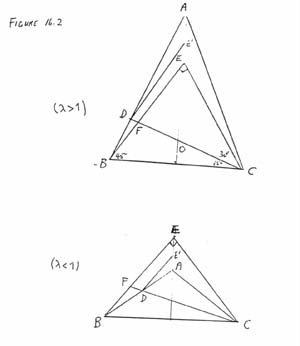
Problem 17.
- 17.
-
The equation resulting
from the Law of Cosines is a conditional equation involving
the variables and not an identity, in particular not an
identity in k. Hence the vanishing of the left side does
not entail the vanishing of the coefficients of the various
powers of k.
-
-
First solution.
See Figure 17.1. The area of the triangle is half of
|
a |
| ______
Öc2 - k2
|
= b |
| ______
Öa2 - k2
|
= c |
| ______
Öb2 - k2
|
|
|
from which
|
a2 c2 - a2 k2 = a2 b2 - b2 k2 = b2 c2 - c2 k2 . |
|
hence
|
a2(c2 - b2) = k2(a2 - b2) b2 (a2 - c2) = k2 (b2 - c2) c2 (b2 - a2) = k2 (c2 - a2) . |
|
Suppose for example that a ³ b. Then a ³ c ³ b from the
first and third of these equations. But then from the middle equation,
a = b = c and the result follows.
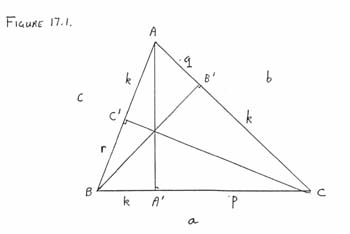
- 17.
-
Second solution. As in the first solution, we have
that
|
|
a2(c2 - b2)
a2 - b2
|
= |
b2(a2 - c2)
b2 - c2
|
|
|
whence 3a2 b2 c2 = a2 c4 + b2 a4 + c2 b4.
>From the AM-GM Inequality,
3a2 b2 c2 = a2 c4 + b2 a2 + c2 b4 ³ 3(a6 b6 c6)1/3 = 3a2 b2 c2, with
equality if and only if a = b = c. Hence, in this case,
a = b = c.
- 17.
-
Third solution.
see Figure 17.1. Let p = A¢C, q = B¢A and
r = C¢B. From Ceva's Theorem,
pqr = k3. Since (q + k)2 - p2 = (r + k)2 - k2,
we have that
|
k2 = p2 + r2 - q2 + 2k(r - q) . |
|
Also
|
k2 = r2 + q2 - p2 + 2k(q - p) , |
|
|
k2 = q2 + p2 - r2 + 2k(p - r) . |
|
Adding these equations yields 3k2 = p2 + q2 + r2.
By the AM-GM Inequality, p2 + q2 + r2 = 3(pqr)(2/3) = k2 with equality if and only if p = q = r. Hence
p = q = r = k and the triangle ABC is equilateral.

- 17.
-
Fourth solution.
See Figure 17.4.
[D. Cheung] Let O be the orthocentre of the
triangle, s = |A¢C |, u = |C¢O | and
|AC¢| = |BA¢| = |CB¢| = 1.
Triangles OAC¢ and OCA¢ are similar, so that
OA¢: OC¢ = A¢C : AC¢ and |OA¢| = su. Then
|OC |2 = s2 (1 + u2), |OB¢|2 = s2 (1 + u2) - 1 and |OB |2 = 1 + s2 u2. Since triangles
BOC¢ and COB¢ are similar,
|
| |
|
|
Þ [1+s2u2][s2 + s2u2 - 1] = u2[s2 + s2 u2] |
| |
|
Þ (s2 - 1)[1 + s2 u2 + s2 u4] = 0 |
| |
|
| |
|
 x
x
Problem 18.
- 18.
-
First solution. Eliminating x from the
two equations of the curves yields the equation
while eliminating the variable y from the two equations
yields the equation
|
4x4 + (24 + k)x2 + (36 - 4k) = 0 (2) . |
|
Observe that (1) is a quadratic in y while (2) is a
quartic in x (as well as quadratic in x2, each with
discriminant k(k+112). In solving for the intersection
point, we find that each root of (1) corresponds to a pair
of roots of (2) with opposite signs.
-
-
Why is tangency not always accompanied by a double
root? First, suppose that k is positive, so that the
curves are a parabola with its axis along the y-axis and
an ellipse centred at the origin. For k < 9, x2 must
be negative for each root of (2), so that while there is
a corresponding real value of y satisfying (1), the
values of x are nonreal. Thus, the curves do not intersect.
When k > 9, (2) has two roots of opposite sign whose squares
are positive and two whose squares are negative. The first
two correspond to two points of intersection that have the same
y-value. Thus, one of the roots of (1) is a positive value of
y giving the ordinate of both intersection points
and the other is negative (since their product -7k/4 is
negative) and corresponds to no real point of intersection.
As k approaches 9, the two intersection points coalesce into
one. There is no doubling of the roots of (1), but of course
(2) has x = 0 as a double root for k = 9.
-
-
Next, suppose that k is negative. To have any real
solutions at all, we must have k £ -112. Let k < -112.
The curves, a parabola and an hyperbola, have four intersection
points, two with positive abscissae and separate ordinates
and their reflected images in the y-axis. As k approaches
-112, the two positive abscissae and the two ordinates
coalesce, and we find that at k = -112, (1) has y = 14
as a double root and (2) has x = Ö[11] and x = Ö[11]
both as double roots. In this case, the double root criterion
turns out to be valid.

